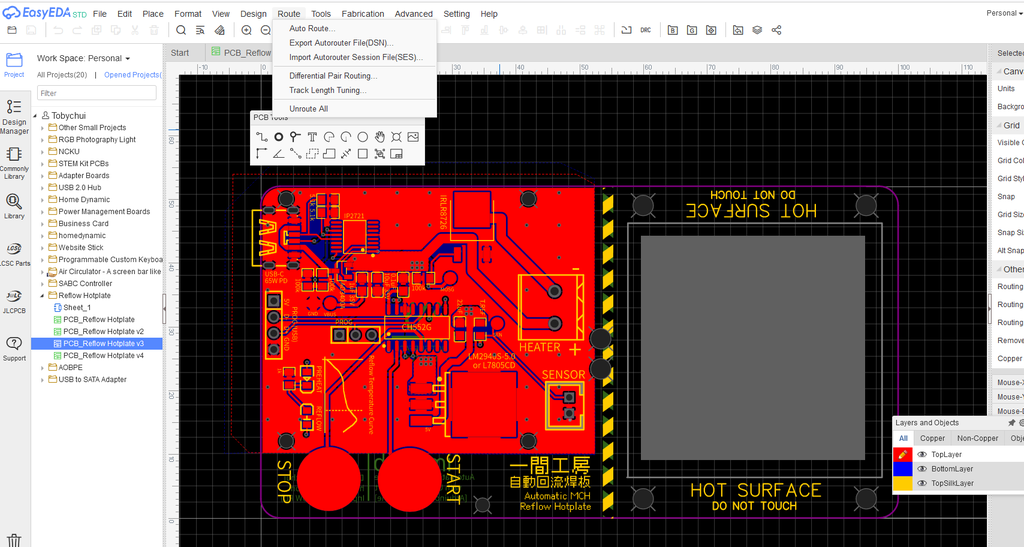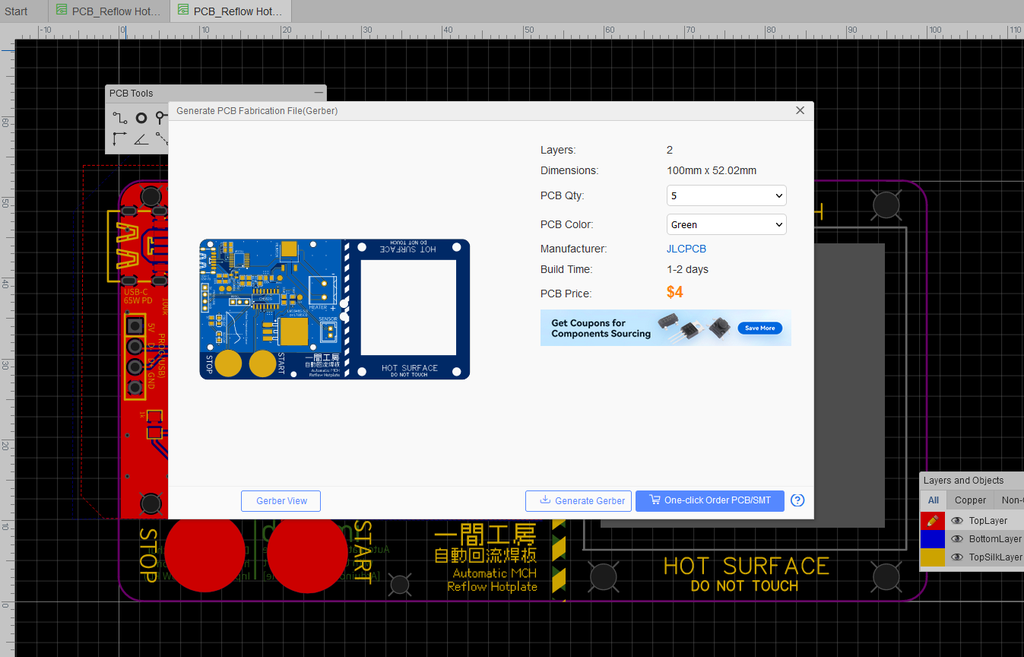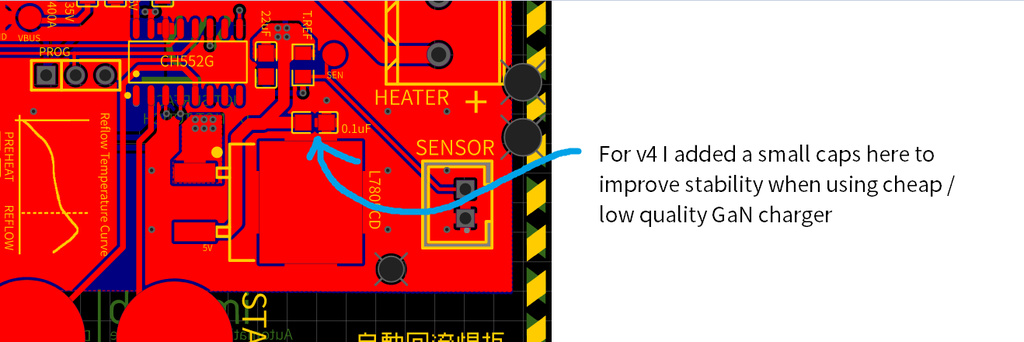-
13D Print the Mounting Base
![3D Print the Mounting Base]()
First you can start by 3D printing the base. It is a simple step. Just get the stl file, slice it and send it to a 3D printer.
-
2Send the PCB to Print
As the PCB is the main component of this build, you can order your PCB at any PCB manufacturer you preferred. This project is sponsored by JLCPCB. If you have never tried to order a PCB before, please feel free to try out JLC services with the link below.
In my case, as the MOQ of the MCH hot-plate is 50 pcs, so I order a bunch of them from JLC so that I could make a few more of them and give them away with only the material costs.
You can find everything you need for the PCB over here on my github repo.
https://github.com/tobychui/MCH-PD-Automatic-Reflow-Hotplate/tree/main/pcb
![]()
![]()
![]() Side Note
Side NoteI am using the v3 design but later I found that adding a small 0.1uF caps over the output of the L7805 improve the overall stability when using cheap / low quality GaN charger with large ripples. This is optional but I recommend adding it if you are making one for yourself.
![]()
-
3Laser Cut the Hot-plate Support Structure
![Laser Cut the Hot-plate Support Structure]()
The hotplate support structure is a piece of 3mm MDF that is wrapped in Kapton tape. This prevent the MDF from smoking and turning black after long period of uses.
-
4Assemble the Temperature Sensor Element
The temperature sensor (glass bulb part only) is glue to the back of the MCH hot-plate with heat-sink adhesive. Note that there are a lot of S922 heat sink adhesive clone out there that cannot handle the temperature stated in its datasheet. So make sure you get them from a seller with good reputation.
You will want to place the thermistor on the bottom side of the MCH and fix it in place with a piece of Kapton tape. Next, slightly bend the glass bulb so it is touching the surface of the MCH. Finally seal if off with a glob of heat sink adhesive.
![]()
![]()
-
5Assemble the Heater Support Structure
Screw the 4 M3 stands off into the PCB and secure them with M3 nuts. Next, fix the MDF heater support structure on top of the stand offs. Make sure not to screw it too tight and leave some space for the thermal expansion.
![]()
![]()
![]() After complete, you will see something like this as shown in the photo below..
After complete, you will see something like this as shown in the photo below..![]()
![]()
-
6Glue the MCH Hot-plate in Place
Use K-704 heat-proof silicone adhesive to glue the MCH hot-plate in place. Make sure to give it a generous amount of glue and make sure all the surface where the hot-plate is touching the MDF is covered with a thick layer of heat-proof glue. If you do not give it enough heat-proof layer, the heater will fall off after a few uses and you will need to redo Step 3, 5 and 6 again to replace the Kepton adhesion layer.
Wait for the glue to dry before proceed to the next step.
![]()
![]()
-
7Solder the MCH and Thermistor to the PCB
After the glue dry, you can route the leads of the MCH through the two large circular holes near the square hole to the back side of the PCB and solder the hot plate power wire to the PCB from the other side.
For the thermistor, you will need to use a lighter to burn off the outer protection layer and expose the inner conductive metal layer before soldering them to the sensor pins on the PCB.
Make sure the two thin wires of the thermistor do not touch or get any close to gether. Otherwise, this might effect the reading of the MCH hot-plate temperature.
![]()
![]()
-
8Flashing the Hotplate Firmware
I am assuming you have basic knowledge on how to use Arduino IDE and install new boards from board manager.
You will need to install this board manager in order to flash the firmware to the hotplate.
https://github.com/DeqingSun/ch55xduino
If your chip is new and there are no code inside, you can flash it directly via the USB 2.54 pins at the bottom of the PCB. As I am lazy at soldering 50 boards I am making, I bought a custom pogo-pin flashing tool to help me with that. However, you can also just solder a standard USB 2.0 (male) header to the pins and plug it into your computer's USB port.
If your CH552 has been flash before, follow detail instruction on my Github repo for overwriting the build-in firmware.
The recommend board settings are as follows.
- CH552
- 16Mhz (internal, 3.3V or 5V)
- Upload Method: USB
The firmware can be found over here
https://github.com/tobychui/MCH-PD-Automatic-Reflow-Hotplate/tree/main/firmware/reflow
![]()
-
9Thermal Testing
In order to test the hotplate, screw the base to the PCB assembly and stick a temperature sensor to the surface of the hotplate with Kapton tape.
Press and hold the "START" button to start reflowing. The yellow LED should start fast blinking indicating the reflow will start in a few seconds.
For detail usage guide, see here
If everything is working, the temperature will peak at around 235 - 245 degree Celsius when the hotplate entered reflow stage. Note that the temperature on the hotplate is slightly hotter than what is recommended by the reflow profile as it is not a reflow oven but an open-air hotplate which I need to accounts for thermal lost to surrounding.
If the reflow seems completed, you can always early-stop the hotplate by pressing the "STOP" button.
![Thermal Testing]()
-
10Reflow Test
After thermal testing seems great, now you can try reflow something. Here I am using a SSOP chip with an adapter PCB to try out my reflow hotplate prototype. The last photo shows the result of reflow after some cleaning.
![]()
![]()
![]()
DIY USB-PD Powered MCH Automatic Reflow Hotplate
A palm sized MCH (Metal Ceramic Heater) based reflow hotplate powered by USB-PD
 tobychui
tobychui


 Side Note
Side Note





 After complete, you will see something like this as shown in the photo below..
After complete, you will see something like this as shown in the photo below..










Discussions
Become a Hackaday.io Member
Create an account to leave a comment. Already have an account? Log In.